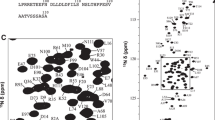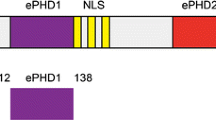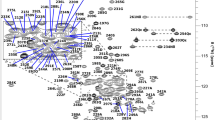Abstract
Kelch-like ECH-associated Protein 1 (Keap1) is a multi-domain protein that functions as an inhibitor of the transcription factor nuclear factor E2-related factor 2 (Nrf2) in the cellular response to oxidative stress. Under normal conditions, Keap1 binds to Nrf2 via its C-terminal Kelch domain and the interaction ultimately leads to the ubiquitin-dependent degradation of Nrf2. It has been proposed that designing molecules to selectively disrupt the Keap1–Nrf2 interaction can be a potential therapeutic approach for enhancing the expression of cytoprotective genes. Here, we reported the 1H, 13C, and 15N backbone chemical shift assignments of the Kelch domain of mouse Keap1. Further, unlabeled Nrf2 peptide containing the Kelch-binding motif was added to the 15N-labeled Kelch sample. 1H–15N HSQC spectra of the protein in the absence and presence of an equimolar concentration of the Nrf2 peptide were presented. A significant number of resonance signals were shifted upon addition of the peptide, confirming the protein–peptide interaction. The results here will not just facilitate the further studies of the binding between Keap1 and Nrf2, it will also be valuable for probing interactions between the Kelch domain and small molecules, as well as a growing list of protein targets that have been identified recently.



Similar content being viewed by others
References
Baird L, Dinkova-Kostova AT (2011) The cytoprotective role of the Keap1–Nrf2 pathway. Arch Toxicol 85:241–272. doi:10.1007/s00204-011-0674-5
Camp ND, James RG, Dawson DW, Yan F, Davison JM, Houck SA, Tang X, Zheng N, Major MB, Moon RT (2012) Wilms tumor gene on X chromosome (WTX) inhibits degradation of NRF2 protein through competitive binding to KEAP1 protein. J Biol Chem 287:6539–6550. doi:10.1074/jbc.M111.316471
Delaglio F, Grzesiek S, Vuister GW, Zhu G, Pfeifer J, Bax A (1995) NMRPipe: a multidimensional spectral processing system based on UNIX pipes. J Biomol NMR 6:277–293
Goddard TD, Kneller DG, SPARKY 3, University of California, San Francisco. http://www.cgl.ucsf.edu/home/sparky/
Itoh K, Wakabayashi N, Katoh Y, Ishii T, Igarashi K, Engel JD, Yamamoto M (1999) Keap1 represses nuclear activation of antioxidant responsive elements by Nrf2 through binding to the amino-terminal Neh2 domain. Genes Dev 13:76–86. doi:10.1101/gad.13.1.76
Itoh K, Tong KI, Yamamoto M (2004) Molecular mechanism activating Nrf2–Keap1 pathway in regulation of adaptive response to electrophiles. Free Radic Biol Med 36:1208–1213. doi:10.1016/j.freeradbiomed.2004.02.075
Kabsch W, Sander C (1983) Dictionary of protein secondary structure: pattern recognition of hydrogen-bonded and geometrical features. Biopolymers 22:2577–2637. doi:10.1002/bip.360221211
Keller R (2004) The computer aided resonance assignment tutorial. Verlag Goldau, Cantina, Switzerland
Komatsu M, Kurokawa H, Waguri S, Taguchi K, Kobayashi A, Ichimura Y, Sou YS, Ueno I, Sakamoto A et al (2010) The selective autophagy substrate p62 activates the stress responsive transcription factor Nrf2 through inactivation of Keap1. Nat Cell Biol 12:213–223. doi:10.1038/ncb2021
Laskowski RA (2009) PDBsum new things. Nucleic Acids Res 37:D355–D359. doi:10.1093/nar/gkn860
Lo SC, Hannink M (2006) PGAM5, a Bcl-XL-interacting protein, is a novel substrate for the redox-regulated Keap1-dependent ubiquitin ligase complex. J Biol Chem 281:37893–37903. doi:10.1074/jbc.M606539200
Lo SC, Li X, Henzl MT, Beamer LJ, Hannink M (2006) Structure of the Keap1:Nrf2 interface provides mechanistic insight into Nrf2 signaling. EMBO J 25:3605–3617. doi:10.1038/sj.emboj.7601243
Ma J, Cai H, Wu T, Sobhian B, Huo Y, Alcivar A, Mehta M, Cheung KL, Ganesan S, et al (2012) PALB2 interacts with KEAP1 to promote NRF2 nuclear accumulation and function. Mol Cell Biol. doi:10.1128/MCB.06271-11
Major MB, Camp ND, Berndt JD, Yi X, Goldenberg SJ, Hubbert C, Biechele TL, Gingras AC, Zheng N et al (2007) Wilms tumor suppressor WTX negatively regulates WNT/beta-catenin signaling. Science 316:1043–1046. doi:10.1126/science/1141515
Marsh JA, Singh VK, Jia Z, Forman-Kay JD (2006) Sensitivity of secondary structure propensities to sequence differences between alpha- and gamma-synuclein: implications for fibrillation. Protein Sci 15:2795–2804. doi:10.1110/ps.062465306
Padmanabhan B, Tong KI, Ohta T, Nakamura Y, Scharlock M, Ohtsuji M, Kang MI, Kobayashi A, Yokoyama S, Yamamoto M (2006) Structural basis for defects of Keap1 activity provoked by its point mutations in lung cancer. Mol Cell 21:689–700. doi:10.1016/j.molcel.2006.01.013
Padmanabhan B, Nakamura Y, Yokoyama S (2008) Structural analysis of the complex of Keap1 with a prothymosin alpha peptide. Acta Crystallogr, Sect F: Struct Biol Cryst Commun 64:233–238. doi:10.1107/S1744309108004995
Strachan GD, Morgan KL, Otis LL, Caltagarone J, Gittis A, Bowser R, Jordan-Sciutto KL (2004) Fetal Alz-50 clone 1 interacts with the human orthologue of the Kelch-like Ech-associated protein. Biochemistry 43:12113–12122. doi:10.1021/bi0494166
Tong KI, Katoh Y, Kusunoki H, Itoh K, Tanaka T, Yamamoto M (2006) Keap1 recruits Neh2 through binding to ETGE and DLG motifs: characterization of the two-site molecular recognition model. Mol Cell Biol 26:2887–2900. doi:10.1128/MCB.26.8.2887-2900.2006
Tong KI, Padmanabhan B, Kobayashi A, Shang C, Hirotsu Y, Yokoyama S, Yamamoto M (2007) Different electrostatic potentials define ETGE and DLG motifs as hinge and latch in oxidative stress response. Mol Cell Biol 27:7511–7521. doi:10.1128/MCB.00753-07
Zipper LM, Mulcahy RT (2002) The Keap1 BTB/POZ dimerization function is required to sequester Nrf2 in cytoplasm. J Biol Chem 277:36544–36552. doi:10.1074/jbc.M206530200
Acknowledgments
This work was supported by an Operating Grant (MOP No. 74679) from the Canadian Institutes of Health Research (CIHR). We are grateful for the use of the NMR facility at National University of Singapore. We would also like to thank the Canadian National High Field NMR Centre (NANUC) for their assistance and use of the facilities. Operation of NANUC is funded by the Natural Science and Engineering Research Council of Canada, and the University of Alberta.
Author information
Authors and Affiliations
Corresponding author
Rights and permissions
About this article
Cite this article
Cino, E., Fan, J., Yang, D. et al. 1H, 15N and 13C backbone resonance assignments of the Kelch domain of mouse Keap1. Biomol NMR Assign 7, 149–153 (2013). https://doi.org/10.1007/s12104-012-9398-6
Received:
Accepted:
Published:
Issue Date:
DOI: https://doi.org/10.1007/s12104-012-9398-6




